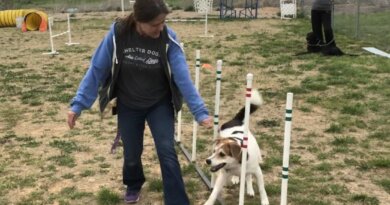8 Life-Saving First Aid Procedures All Dog Owners Should Know
As responsible pet owners, we try to do everything possible to keep our dogs happy and healthy. We buy them quality food, we keep their bowls full of freshwater, we take them on regular visits to the vet, and we schedule time for them to get plenty of exercise. But how many of us are prepared to perform first aid should our dogs need it?
Below are 8 first aid tips that you should read since they could potentially help to save your dog’s life in the case of emergency:
1. Wounds
While most wounds aren’t life-threatening, it’s still important to know how to stop any bleeding by applying a pressure wrap. You should have a dog first aid kit<, and it should be stocked with gauze and non-adhesive wraps in order to apply pressure and protect the wound. Many owners also may want to keep a muzzle in their kit since even the most friendly dogs are liable to bite if they’re in pain.
In order to help control bleeding, the American Veterinary Medical Association (AVMA) says to do the following:
• Press a clean, thick gauze pad over the wound and apply pressure with your hand until the blood begins to clot – this can take a minimum of 3 minutes, longer if the wound is larger.
• For severe bleeding on your dog’s extremities, apply a tourniquet using gauze and an adhesive wrap.
• Since pressure wraps minimize circulation, loosen the tourniquet for 20 seconds, every 15-20 minutes.
• Seek veterinary attention immediately.
If a wound is severe enough, or if it’s caused by an extremely stressful event like an animal attack or car accident, shock can be a very real and serious possibility.
2. Shock
Shock occurs when the circulatory system fails to properly function as a result of blood loss, heart failure, anaphylaxis, extreme temperatures, or nervous system injuries. Shock causes a lack of oxygen flow to the brain, body tissues, and organs – and this can quickly become a life-threatening emergency.
Signs of shock in dogs include:
• Rapid pulse
• Low body temperature
• Grey-blue mucous membranes (gums, tongue, etc.)
• Weakness and dizziness
• Nausea and vomiting
• Shallow or rapid breathing
• Gasping for air
• Loss of consciousness
Dog first aid steps for shock:
• Lie your dog on its right side
• Fold a blanket under their hind end to elevate it – as this encourages blood flow back towards their heart and brain.
• Cover them with a warm blanket – since shock will cause their body temperature to rapidly decrease
• Seek immediate emergency care
3. Poisoning
If your pet should happen to ingest something toxic, then you should immediately call your veterinarian or the Animal Poison Control Center hotline on 888-4ANI-HELP (888-426-4435). Animal Poison Control is available 24 hours a day, and 365 days a year. And be sure to have on hand the packaging of the substance that your dog has ingested.
First aid techniques may involve inducing vomiting or seeking emergency supportive care from your vet. While some substances are best removed from the body as soon as possible, others can cause even more damage if they’re thrown up – so it is best not to induce vomiting without first seeking professional advice.
Depending on the type of exposure, you may also have to flush out your dog’s eyes, or thoroughly wash their skin and fur.
It would also be wise to familiarize yourself with the most common household poisons, as well as toxic foods or plants, and how to avoid them.
4. Seizures
Seizures can come in a variety of forms. Some cause dogs violently convulse, while others present themselves more subtly, such as rapid eye movement or twitching in one limb. While seizures can be very frightening to witness in your pet, they are typically not life-threatening unless they cannot be controlled.
Should your dog experience a seizure, don’t attempt to move them or restrain them – instead you should clear the area of any potential hazards. In addition, be sure to record the length of time that the seizure lasted in order to be able to report it to your vet.
Once the seizure has passed, your pet is likely to be groggy and lethargic for several hours, so it’s important to make sure they’re comfortable. If this is your dog’s first seizure, then immediately get them to the vet. However, if your dog has a history of seizures, just follow your vet’s care plan.
5. Choking
Warning: A dog who is choking is likely to be frightened, therefore they’re more likely to bite – approach with caution.
Many dogs will cough and hack, but that isn’t necessarily them choking. In order to determine if your dog is choking and in need of emergency first aid, do the following:
• Check for labored breathing.
• Gently open your dog’s mouth to see whether an object is blocking the airway.
• If visible, try to dislodge it with a hooked index finger – but be extremely careful not to further push it down their airway.
• If you can’t remove the object, or your dog collapses, then place both of your hands on the side of the rib cage and apply firm quick pressure, release and repeat.
• You can also try laying your dog on its side and striking the rib cage firmly with the palm of your hand 3-4 times – the idea behind this is to sharply push air out of their lungs and push the object out from behind.
• Keep repeating these techniques until the object is dislodged or until you arrive at the vet’s office.
• Seek emergency veterinary care
Even if you manage to dislodge an object from your dog’s throat, you still need to seek medical attention to make sure that there aren’t any lingering complications. Dogs who’ve been choking run the risk of having swallowed potentially harmful substances or aspirate fluid into the lungs.
6. Apnea (Not Breathing)
You can determine if your dog has stopped breathing by watching for the rise and fall of the chest, or by placing your hand in front of their nose to feel for their breath. Should keep in mind that when a dog is asleep, their respiration is slower and deeper.
If you determine that your dog is in respiratory distress, the AVMA recommends the following:
• Open the airway by gently grasping the tongue and pulling it forward (out of the mouth) until it is flat.
• Check the dog’s throat to see if there are any foreign objects obstructing the airway.
• Perform rescue breathing by holding your dog’s muzzle closed and breathing directly into the nose until the chest expands.
• Once the chest expands, continue the rescue breathing once every 4 or 5 seconds.
• Be sure to check for a pulse, like in the video below. If absent, proceed to cardiac arrest procedures.
Ideally, these first aid techniques should be performed en route to the nearest emergency vet’s office in order to get professional treatment.
7. Cardiac Arrest
The signs of cardiac arrest are very similar to those of the advanced stages of shock. Your dog will lose consciousness and stop breathing. Since the heart is no longer pumping oxygenated blood through the body, the mucous membranes will appear pale or blue-gray in color.
Cardiac arrest is one of the most terrifying emergencies your dog can face, but with your help, they can survive it. Getting your pet to the vet’s office is key, so all first aid efforts should be performed while en route to the animal hospital.
Dog First Aid For Cardiac Arrest:
• First, check to make sure your dog doesn’t have anything blocking their airway and begin performing the rescue breathing technique from above.
• Check for a pulse, like in the video below.
• If no pulse, lay them on their RIGHT side so the heart is facing up – it’s located in the lower half of the chest on the left side, just behind the front left leg.
• Place one hand beneath your dog while placing the other hand over their heart.
• Press down gently on the heart – about one inch down for medium-sized dogs – 100-120 times per minute.
• Alternate 30 chest compressions with two rescue breaths and check for signs of life every two minutes.
• Continue until your dog’s heart restarts or a veterinary professional is able to take over.
It is important to familiarize yourself with assessing your dog’s condition, as well as performing these CPR techniques in the following video by Melanie Monteiro, a pet first aid instructor.
8. Heatstroke
Dogs can become dangerously overheated if they have a very active day in the heat, or if they’re left in a hot car. Unlike humans, dogs only have sweat glands in their paw pads, and some on their nose, so they can only really cool down by panting. This leaves them quite susceptible to hyperthermia. Overweight dogs, or those who have short muzzles, are even more prone to heatstroke.
Symptoms of heatstroke to watch out for are:
• Excessive panting
• Drooling
• Fast or irregular heartbeat
• Vomiting blood
• Muscle tremors
• Seizures
If you believe your dog is suffering from heatstroke, it is important to immediately remove them from the heat. It’s essential to get them to the vet in order to prevent brain or organ damage. However, on the way to the clinic you can help them by slowly lowering your dog’s body temperature. It is important to lower the body temperature at a slow and steady pace so as to avoid the risk of shock.
In order to do so, perform the following:
• Apply rubbing alcohol to your dog’s paw pads to help draw heat out of the body.
• Place cool, wet towels around the body, head, and neck, but avoid the eyes, nose, and mouth.
• If possible, replace it with fresh, cool towels every couple minutes until you arrive at your vet’s.
The more you know about first aid for your dog, the better. So it’s not a bad idea to further your own education of dog first aid. After all, the more comfortable you feel in your own knowledge, the more comfortable and calm you’ll feel stepping in during an emergency situation. Both the American Red Cross, and Pet Tech offer courses in pet first aid and CPR, along with many local animal shelters. It’s also possible to find additional information and resources from the professionals at the AVMA. After all, knowledge is power and nothing is better than helping to save your furbaby’s life in an emergency situation.





Medscape Drugs & Diseases. All trends of medicament.
canadian online drugs
Get warning information here. Definitive journal of drugs and therapeutics.
Szpiegowskie telefonu – Ukryta aplikacja śledząca, która rejestruje lokalizację, SMS-y, dźwięk rozmów, WhatsApp, Facebook, zdjęcie, kamerę, aktywność w Internecie. Najlepsze do kontroli rodzicielskiej i monitorowania pracowników. Szpiegowskie Telefonu za Darmo – Oprogramowanie Monitorujące Online.
seo продвижение сайта услуги
Melhor aplicativo de controle parental para proteger seus filhos – Monitorar secretamente secreto GPS, SMS, chamadas, WhatsApp, Facebook, localização. Você pode monitorar remotamente as atividades do telefone móvel após o download e instalar o apk no telefone de destino.
canadian pharmacy viagra canadian pharmacy canadianphrmacy23.com
cheap cialis online canada pharmacy [url=http://canadianphrmacy23.com/]list of canada online pharmacies[/url]
Pingback:spiraldynamics
canadian pharmacy cialis 20mg try this website
online canadian pharmacies [url=http://canadianphrmacy23.com/]Canadian Pharmacy Online to canadianphrmacy23.com[/url]
Pingback:Spiral Dynamics
Pingback:vxi.su
Amicus cognoscitur amore, more, ore, re — Друг познаётся по любви, нраву, лицу, деянию.
Pingback:site